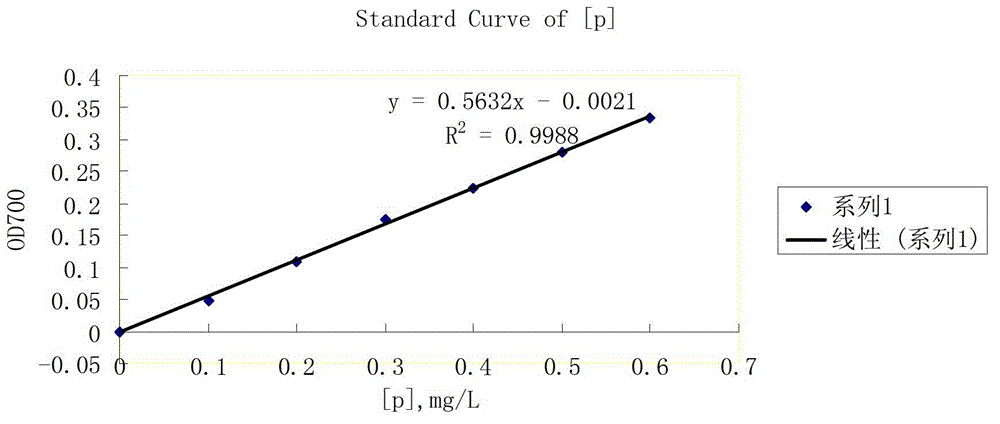Genetically modified efficient phosphate solubilizing engineering bacterial strain and application thereof
A technology of engineering bacteria and genes, applied in applications, microorganism-based methods, bacteria, etc., can solve problems such as low frequency of beneficial mutations, difficulty in effectively controlling the direction and nature of mutations, and no genetic modification of phosphorus-solubilizing bacteria.
- Summary
- Abstract
- Description
- Claims
- Application Information
AI Technical Summary
Problems solved by technology
Method used
Image
Examples
Embodiment 1
[0048] Example 1, construction of highly efficient phosphorus-solubilizing engineering bacteria PS57H1
[0049] The construction of highly efficient phosphorus-solubilizing engineering bacteria, Bacillus amyloliquefaciens (Bacillus amyloliquefaciens) PS57H1CGMCC No.6089, the specific method includes the following steps:
[0050] 1. Screening of phosphobacteria PS57 and identification of 16S rDNA
[0051] 1. Primary screening
[0052] The screened items were the rhizosphere soils of crops or horticultural plants from Xiaotangshan in Beijing, Hefei in Anhui, Langfang in Hebei, Yichang in Hubei, Yantai in Shandong, Jiadengling in Xinjiang, and Nanyang in Henan. The specific screening method is as follows: Weigh 5g of each soil sample, put them into Erlenmeyer flasks filled with 100mL sterile water and glass beads, vibrate vigorously on a shaker for 30min, then keep in a water bath at 80°C for 15-20min. Then serially diluted with sterile water to 10 -3 、10 -4 、10 -5 、10 -6 、...
Embodiment 2
[0102] Example 2. Detection of Phosphorus Solubilizing Ability of Bacillus amyloliquefaciens PS57H1 CGMCC No.6089 (Phosphorus Solubilizing Ability of Inorganic Phosphorus)
[0103] 1) Qualitative determination of plates
[0104] Scrape off the bacterial lawn after activating the strains to be tested, and add an appropriate amount of sterile water to make a uniform bacterial suspension (the bacterial concentration is CFU (unit / ml) = 1.84×10 9 ), use a sterilized dropper to drip the bacterial suspension into the bacterial screening medium containing inorganic phosphorus (the formula is: glucose 10g, tricalcium phosphate 5g, ammonium sulfate 0.5g, sodium chloride 0.2g, magnesium sulfate 0.1g , Potassium chloride 0.2g, yeast powder 0.5g, manganese sulfate 0.002g, 0.4% bromophenol blue (pH6.7) 6mL, agar 18g, distilled water 1000mL, pH7.0-7.5, the culture medium was prepared by conventional methods before use 115°C for 30min), evenly drop 4 spots on the solid culture dish, transfer...
Embodiment 3
[0111] Embodiment 3, preparation highly efficient phosphate-dissolving microbial bacterial agent
[0112] The fermentation process of Bacillus amyloliquefaciens PS57H1 CGMCC No.6089:
[0113] 1) Prepare inorganic phosphorus bacterial liquid medium, the formula is: glucose 10g, ammonium sulfate 0.5g, yeast powder 0.5g, sodium chloride 0.3g, potassium chloride 0.3g, magnesium sulfate 0.3g, ferrous sulfate 0.03g, sulfuric acid Manganese 0.03g, calcium phosphate 5g, distilled water 1000mL, pH 7.0-7.5, the medium was sterilized at 115°C for 30min by conventional methods before use;
[0114] 2) Inoculate Bacillus amyloliquefaciens (Bacillus amyloliquefaciens) PS57H1 CGMCC No.6089 at a ratio of 5% in the liquid medium for inorganic phosphorus bacteria in step 1), and culture it for 20-24 hours at a shaker flask rotating speed of 180-200r / min , to obtain the highly efficient Bacillus phosphate solubilis PS57H1 fermented bacterial liquid, and obtain a solid microbial agent after dryin...
PUM
 Login to View More
Login to View More Abstract
Description
Claims
Application Information
 Login to View More
Login to View More - Generate Ideas
- Intellectual Property
- Life Sciences
- Materials
- Tech Scout
- Unparalleled Data Quality
- Higher Quality Content
- 60% Fewer Hallucinations
Browse by: Latest US Patents, China's latest patents, Technical Efficacy Thesaurus, Application Domain, Technology Topic, Popular Technical Reports.
© 2025 PatSnap. All rights reserved.Legal|Privacy policy|Modern Slavery Act Transparency Statement|Sitemap|About US| Contact US: help@patsnap.com



